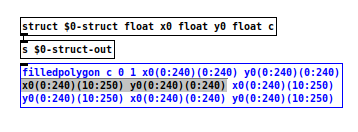oh, great - thanks for all the replies! 
@ingox
Is it possible that you are using @Balwyn's xy-patch
no, not this patch, but yeah, i was inspired by another patch i found here somewhere in the forum... don't remembr exactly which one, but this got me started - i'm still trying to get into data structures, which is quite hard sometimes, so it's really good to have some patches to get started with...
It is that data structures get an invisible dragging area of 10 or 12 pixels squared. This is not documented and i don't remember the exact circumstances how the area is created. But the dragging area is unfortunately independent from the displayed form in size, so a bigger form can not be dragged at any point. Hope that helps a little bit. 
yeah, i was afraid, this could be the answer! 
@Balwyn said:
@toxonic just multiplying the outputs by 0.01 gives the same result
yes, correct - it's not a big deal to convert the output into any range, but i just hoped to keep things simple.... 
@Balwyn said:
@toxonic You may get some insight into using the hotspot without a pointer with this offering I uploaded a few years ago,
https://forum.pdpatchrepo.info/uploads/files/1498974324729-xydrag.zip
The template is a little confronting but shows that by using just one xy pair (px and py) multiple nodes can be created using scaling and constraining (eg px(-100:100)(20:20) py(-100:100)(-20:-20)).
the x and y output from the grid is interpreted as greater or smaller than the previous which activates a plus or minus counter for the output values
oh, sweet jesus, this is a huge template within the [pd template] patch.... i have to go to work now, but i'll try to figure it out, when i'm at home again! 
thank you all for your answers, great forum! 












 let's look at the third pair, which i guess, is the point to th right from the second one. why is x0 bound between 0 an 240 on the x-axis? shouldn't it be bound to (10:250), as it should have a 10 pixel offset to the other points? sorry for my silly questions, but this is really confusing to me...
let's look at the third pair, which i guess, is the point to th right from the second one. why is x0 bound between 0 an 240 on the x-axis? shouldn't it be bound to (10:250), as it should have a 10 pixel offset to the other points? sorry for my silly questions, but this is really confusing to me...